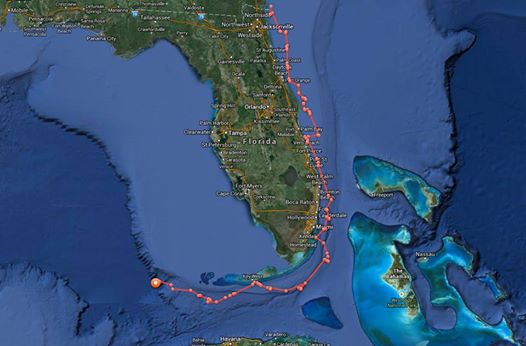Update, 9:45 a.m. June 2:
Katharine the great white shark continues swimming westward from Dry Tortugas National Park.
At 4:03 a.m. today, Katharine “pinged” roughly 70 to 80 miles from the national park.
Original story:
Katharine the restless great white shark is swimming from the Florida Straits into the Gulf of Mexico, captivating marine scientists with her “historic” marathon migratory odyssey.
At 7:28 and 7:53 a.m. Sunday, the red satellite transmitter on Katharine’s dorsal fin “pinged” roughly 60 miles west of Dry Tortugas National Park.
OCEARCH researchers captured and tagged the 2,300-pound shark last August off Cape Cod. Katharine has traveled more than 4,200 miles since, tracing a GPS path along the Atlantic seaboard past Brevard County and swinging south of the Florida Keys.
Tracking an Atlantic great white shark into the Gulf of Mexico is a historic scientific event, OCEARCH founder Chris Fischer said.
“We’ve tracked sharks that were in the Atlantic into the Gulf. But we never have had one show us exactly how they entered the Gulf. It’s cool for Katharine to actually be showing us that route,” Fischer said.
“We now know that these white sharks are moving all along the eastern and southern coasts of Florida. We just didn’t really know that they were doing that all along. The awareness level has skyrocketed,” he said.
Betsy, one of Katharine’s OCEARCH-monitored cohorts, is a 1,400-pound great white that was also tagged last August off Cape Cod. Unexpectedly, Betsy “just kind of showed up” near the middle of the Gulf of Mexico on April 18, Fischer said.
Since Betsy’s previous ping was detected Dec. 12 — roughly 900 miles offshore from New Jersey — her four-month journey into the Gulf of Mexico remains a mystery. Her transmitter last pinged May 8 about 100 miles off of Bonita Springs.
By Thursday night, while Katharine was prowling between Key West and Dry Tortugas National Park, Fischer said his research team was “waiting on pins and needles” to see if she would enter the Gulf of Mexico.
Fischer said scientists may eventually use Katharine’s data to help protect her species’ migratory routes and breeding sites.
“We’re defining the range of the white shark. One of the things you have to do to protect these great apex predators is, first, you’ve got to define the range. And we don’t even know what that is,” Fischer said.
Click here to track Katharine’s progress
This article was re-posted from Florida Today 6/1/2014 – click here for the original article






